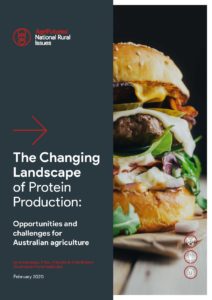
The global market for protein is growing. That’s animal-sourced, plant-sourced and alternative proteins. And as our population continues to rise there will be new demand for animal protein that will happen alongside market share gains for alternative proteins.
That’s one of the key findings from our new research report The Changing Landscape of Protein Production, which is good news indeed for Australian agriculture.
In fact, a new study funded by AgriFutures Australia, found that there’s an estimated additional opportunity for the Australian protein market valued at $19.9 billion by 2030. Of this opportunity $3.1 billion is for alternative protein categories. This doesn’t just mean growth for non-traditional proteins like insects, algae, seaweed and cultured meat, but also for Australian farmers who produce plant-sourced proteins such as pulses.
The results of this research perhaps contrast some of the sensationalist reporting and news we have been hearing lately about the effects of more people choosing flexitarian and vegan diets. Really, it’s a win-win for consumers and agricultural producers alike. The alternative protein market is providing consumers with more choice and variety and it’s no threat to our traditional protein production systems, quite the opposite in fact. As new demand for animal protein from a growing global population outweighs the additional market share that alternative proteins may gain in the next decade what we’re going to see is overall growth in global protein consumption.
There’s an opportunity for producers to look at a meal as a whole nutritional opportunity and stop thinking about our individual products and commodities. It’s not about worrying what is on people’s plates – meat, vegetables, pulses, eggs, dairy, alternative proteins – but making sure there is enough protein on everyone’s plates.
This is a significant shift in mindset that was explored on day one of evokeAG. 2020, where a panel of leading alternative protein disrupters talked about the enormous opportunities for animal protein, plant protein and alternative protein markets to thrive by coexisting.
The growth of our agriculture sector depends on our ability to meet the world’s demand for food, especially protein, as this necessarily means cooperation between traditional and alternative protein producers.









